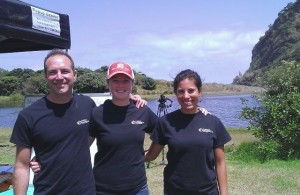Community stakeholders met with Auckland Council regional stormwater team at Arataki Visitor Centre today to discuss action in cleaning up contaminated West Coast lagoons. Manager Phil Brown explained that on amalgamation Council “dropped the ball” on this issue, but there are now nine parts of Council working collaboratively on solutions.
The missing part was partnering with the community, with this workshop being the first stage in a process of working together.
Kirsten Meijer presented on findings of DNA testing of e coli found in the lagoons. At the Marawhara (North Piha) the sources were people, dogs and birds, while at the Wekatahi, it was dogs and birds.
At Piha lagoon, the sources were humans, dogs and birds. The highest levels were found in the Piha lagoon itself, as well as below the Seaview Road bridge and by the entrance to the Maungaroa Lookout Track in Glen Esk Road.
At Karekare, sources were human and dog for Karekare Stream and human for Company Stream.
Dave Kirk of Morphum contractors which works on the issue for Council, reported on testing his firm has been doing on the Council’s own systems at public toilets and the like. He said that the Piha Lagoon was the most complex system because of the number of systems contributing to it, but that the effluent quality is generally very good. The limit is 15, but at Piha the treatment system is usually rated under 5. Effluent is filtered twice and is also UV disinfected. The Piha lagoon site is potentially the most problematic because of the lack of setbacks from waterways.
Dan Dukker of Ecomatters Trust reported on its efforts with education in the local community, which took the form of open days, walkarounds and door knocking. They talked to about 100 people in all, and found that at Piha the further away from the lagoon that they went, awareness of lagoon problems diminished even though septic tank run-off is entering the stormwater system all through the catchment.
Around 30 free wastewater checks were carried out, with 40% of the systems checked having significant problems, and this applied to both older and newer systems. In newer systems, disposal lines often failed, they could be damaged by activity such as gardening or become tangled or blocked.
It is advised to have at least an annual check of wastewater systems, but 90% of people do not do this. This was seen as an opening for plumbers in our coastal settlements. Regular maintenance reduced the incidence of significant problems by half.
Saffron Toms of the Waitakere Ranges Board talked about the $2500 subsidy being offered by the local board to property owners that improve their systems, and was able to report that the first application had been received – to replace a long-drop.
The discussion at the workshop raised many ideas about how to socialise the issue in communities. There will be further workshops to explore further how Council and communities can work together.



